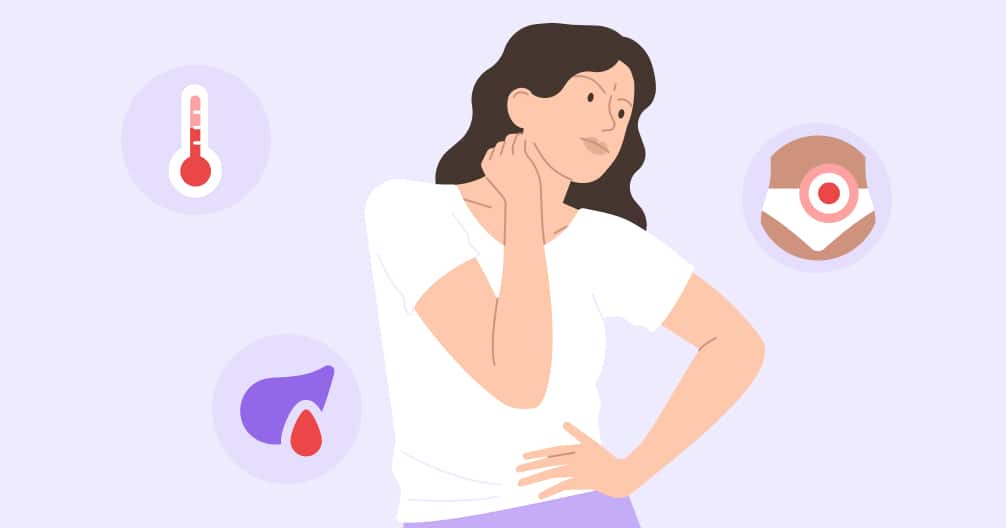Postmenopausal bleeding (PMB) can be unsettling for many women, especially when they thought their menstrual cycles were behind them. If you’ve gone an entire year without a period and then notice spotting or bleeding, it’s important to take it seriously. While most causes of PMB are not life-threatening, it can sometimes be a sign of a more serious condition. Let’s dive into what PMB is, why it happens, and how it’s treated in a conversational and easy-to-understand way.
What Is Postmenopausal Bleeding?
Simply put, postmenopausal bleeding refers to any vaginal bleeding that occurs after menopause—a phase marked by 12 months without a menstrual period. It can be light spotting, pinkish discharge, or even bleeding that mimics a regular period.
While the causes are often benign, about 10% of cases may indicate something more serious, such as endometrial cancer, so it’s crucial to get checked by your doctor. Think of it this way: your body is trying to tell you something, and it’s better to listen sooner rather than later.
Common Causes of Postmenopausal Bleeding

There are several possible culprits behind PMB, and most of them are noncancerous and manageable. Let’s explore the most common ones.
1. Vaginal and Endometrial Atrophy (Thinning)
As estrogen levels drop after menopause, the tissues of the vagina and uterine lining can thin out and become more fragile. This condition, known as vaginal or endometrial atrophy, can lead to spotting or bleeding, especially after sexual activity.
- Symptoms: Vaginal dryness, discomfort during sex, and occasional bleeding.
- Treatment: Your doctor might recommend lubricants, vaginal moisturizers, or low-dose vaginal estrogen therapy to improve tissue health.
2. Polyps
Polyps are small, soft growths that can develop in the uterus or cervix. While most polyps are benign, some can lead to abnormal bleeding and may need removal.
- Symptoms: Irregular bleeding or spotting, especially after intercourse.
- Treatment: Polyps are usually removed through a minor surgical procedure called hysteroscopy.
3. Endometrial Hyperplasia
When the uterine lining (endometrium) becomes too thick due to excess estrogen, it’s called endometrial hyperplasia. This can sometimes lead to bleeding and, in rare cases, increase the risk of uterine cancer.
- Risk Factors: Obesity, hormone replacement therapy, and polycystic ovary syndrome (PCOS).
- Treatment: Hormonal treatments, such as progestin therapy, or procedures to remove excess tissue.
4. Uterine Fibroids
Fibroids are benign growths in the uterus that are more common during the reproductive years but can persist after menopause, especially if your body produces small amounts of estrogen from fat cells.
- Symptoms: Pelvic pressure, bloating, and occasional bleeding.
- Treatment: Medication to shrink fibroids or surgery to remove them if they cause significant symptoms.
5. Hormone Replacement Therapy (HRT)
Hormone therapy can help manage menopause symptoms like hot flashes and vaginal dryness, but it may cause occasional spotting or light bleeding, especially in the early months of treatment.
- Management: Adjusting hormone dosages under the guidance of your doctor can usually resolve the issue.
Rare but Serious Causes of Postmenopausal Bleeding
While the above causes are more common, it’s important to be aware of less frequent but potentially more serious causes of PMB.
1. Endometrial Cancer
Around 10% of women with postmenopausal bleeding are diagnosed with endometrial cancer. This type of cancer affects the lining of the uterus and is often detected early because of abnormal bleeding.
- Risk Factors: Obesity, diabetes, hypertension, and late menopause.
- Diagnosis: Doctors may perform a biopsy or ultrasound to confirm the presence of cancer.
- Treatment: Surgery, such as a hysterectomy, is often recommended, sometimes followed by radiation or chemotherapy.
2. Cervical and Ovarian Cancer
- Cervical Cancer: Often accompanied by bleeding after . Routine Pap smears can help catch it early.
- Ovarian Cancer: Some types, like granulosa cell tumors, produce estrogen that can lead to postmenopausal bleeding.
3. Infections and Inflammation
Infections like endometritis (inflammation of the uterine lining) or certain sexually transmitted infections (STIs) can also cause bleeding.
4. Trauma or Injury
Bleeding can result from vaginal injuries due to sexual activity or accidental trauma.
Risk Factors for Postmenopausal Bleeding
Some women may be more prone to PMB due to:
- Obesity: Excess body fat increases estrogen levels.
- Diabetes or Hypertension: These conditions are linked to vascular changes that may affect uterine health.
- Hormone Therapy: Prolonged use of estrogen without balancing it with progesterone can thicken the uterine lining.
- Family History: A family history of reproductive cancers may increase the likelihood of certain conditions.
Diagnostic Tests for PMB
If you experience PMB, your doctor will likely recommend a combination of tests to identify the cause. Here’s a quick rundown of what you can expect:
| Test Name | Purpose |
|---|---|
| Pelvic Exam | Checks for abnormalities in the vagina or cervix. |
| Transvaginal Ultrasound | Measures the thickness of the uterine lining and identifies growths. |
| Endometrial Biopsy | Removes a small sample of uterine tissue to check for cancer or hyperplasia. |
| Hysteroscopy | Uses a small camera to examine the inside of the uterus. |
| Pap Smear | Detects cervical abnormalities and infections. |
How Is Postmenopausal Bleeding Treated?
The treatment for PMB depends entirely on the underlying cause. Here are some common approaches:
- For Vaginal Atrophy: Moisturizers, lubricants, or localized estrogen therapy.
- For Polyps or Fibroids: Surgical removal is often recommended.
- For Hormone-Related Bleeding: Adjusting or stopping hormone therapy.
- For Endometrial Hyperplasia or Cancer: Progestin therapy, D&C, or hysterectomy.
- For Infections: Antibiotics or antifungal medications.
When Should You See a Doctor?
Even if the bleeding is light or happens just once, don’t ignore it. It’s always better to get evaluated early. You should see a doctor immediately if:
- You experience heavy bleeding or pass clots.
- You notice recurring spotting over several weeks.
- You have other symptoms like pelvic pain, bloating, or unexplained weight loss.
Tips for Preventing and Managing PMB
While some causes of PMB are beyond your control, maintaining good overall health can lower your risk.
- Stay Active: Exercise helps regulate hormones and maintain a healthy weight.
- Healthy Diet: Focus on whole grains, fruits, vegetables, and lean proteins.
- Regular Check-Ups: Routine pelvic exams and Pap smears are essential for early detection.
- Avoid Smoking: Smoking is linked to various gynecological conditions.
Final Thoughts
Postmenopausal bleeding might seem alarming, but it’s a symptom not a diagnosis. Most cases are caused by manageable conditions like vaginal atrophy or benign growths. However, since it can also signal something more serious, like endometrial cancer, don’t hesitate to consult your doctor. Remember, early detection and treatment lead to better outcomes, and staying proactive about your health is the best way to navigate this phase of life with confidence.
References
- American College of Obstetricians and Gynecologists. (2025). Understanding Abnormal Uterine Bleeding.
- National Cancer Institute. (2024). Endometrial Cancer Risk Factors and Statistics.
- Mayo Clinic. (2025). Postmenopausal Bleeding Causes and Treatments.
- Cleveland Clinic. (2025). Management of Vaginal Bleeding in Postmenopausal Women.
- Women’s Health Network. (2025). Postmenopausal Health and Hormone Therapy Overview.


